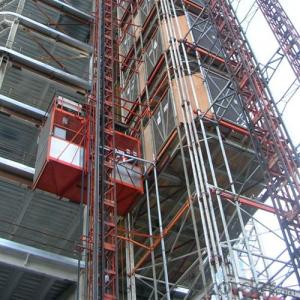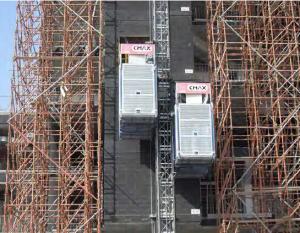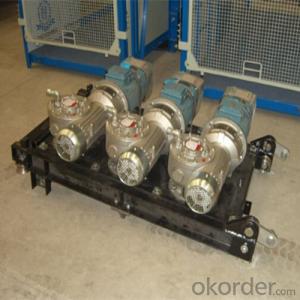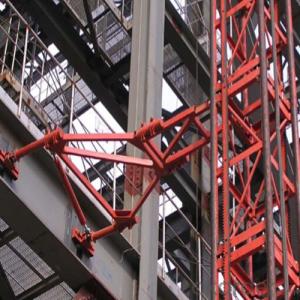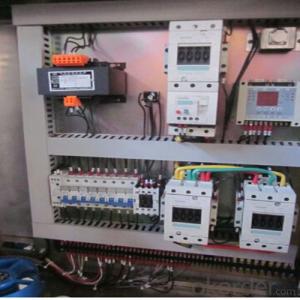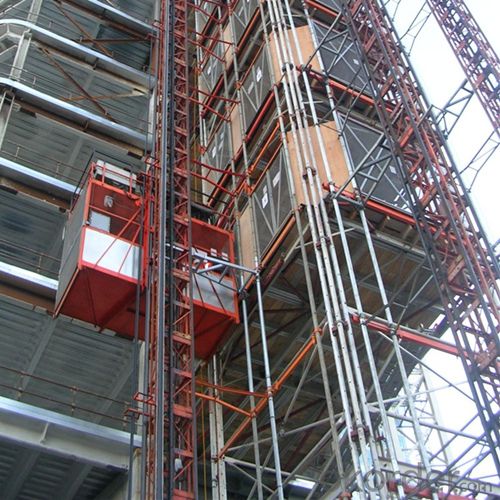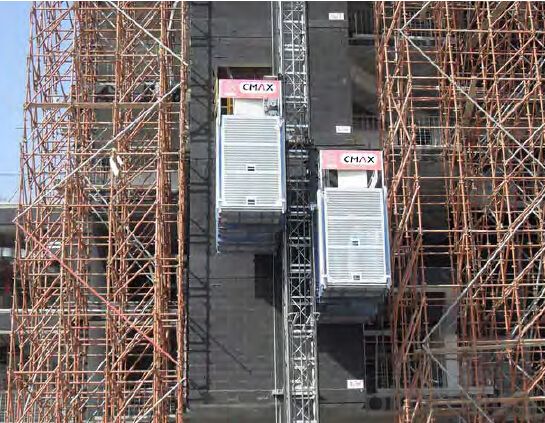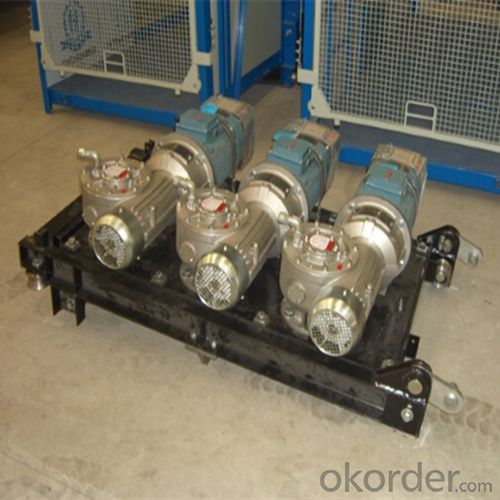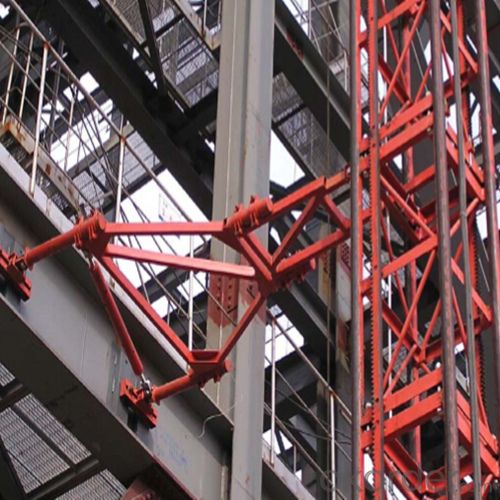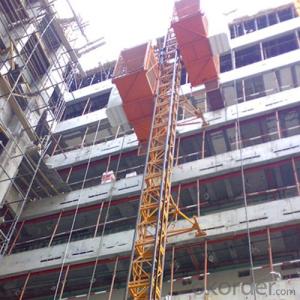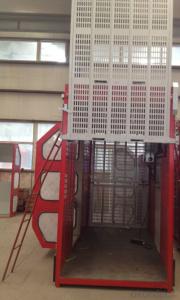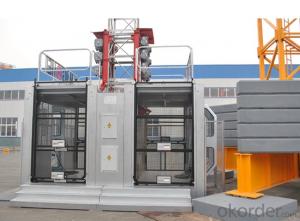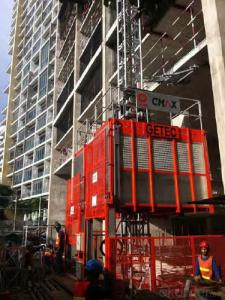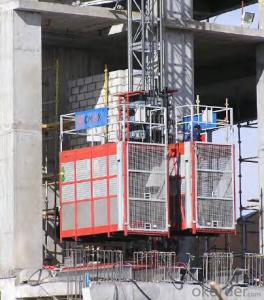Construction Hoist SC200Z,by Aluminum Molded Board, Punched-plate or Figured Aluminm Board
- Loading Port:
- China main port
- Payment Terms:
- TT or LC
- Min Order Qty:
- 1 unit
- Supply Capability:
- 30 unit/month
OKorder Service Pledge
OKorder Financial Service
You Might Also Like
SC Hoist is a Rack and Pinion EL. Lift, used on construction site for transportation of personnel and materials. It is installed and dismounted conveniently and can grow as high as the buildings grow in height.
There are single cage and twin cage hoists. A single cage can be quickly transformed into twin cage hoist by adding a cage and other parts. The hoist payload can be increased by adding counterweight equipment.
SC Hoist has reliable electrical and mechanical safety device. It is a efficient and safety vertical transporting equipment.
Structure of Construction Hoist Description
Feature: Construction Hoist Condition: New Application: Construction
Payload(kg):2700 Lifting Speed(m/min):33 Motor Power(kw): 3*15
Safety Device: SAJ50-1.2 Cage: Single Counterweight: No
Certification: CE,ISO Place of Origin: China(Mainland) Model Number: SC200Z
Construction Hoist Specifiction
Main technical data | Unit | Value |
Rated load | kg | 2000 |
Rated erection load | kg | 1000 |
Jib attachment rated load | kg | 300 |
Cage size | m | 3.0×1.3×2.5 |
Maximum lifting height | m | 450 |
Lifting speed | m/min | 0~63 |
Rated output | kW | 3×18.5 |
Voltage rating | V | 380/440 |
Rated frequency | Hz | 50/60 |
Rated current | A | 3×37.8 |
Power supply fuses | A | 140 |
Protective class | / | IP55 |
Load duration factor | / | FC-25% |
Safety device | m/s | 1.4 |
Enclosure weight | kg | 980 |
Cage weight | kg | 2000 |
Counterweight | kg | / |
Mast section weight | kg | 125/145/160 |
Mast section length | mm | 1508 |
If you have special requirement on power, please state it when order the consignment.
We can produce the cage and lengthen the tie-in according to the size the customer requested.
We can heighten the erection height according to the customer’s request.
“/” means the item does not exist.
Packaging & Delivery of Construction Hoist
Packaging Detail: Nude package Delivery Detail: 25-30days
Building hoist inmmages
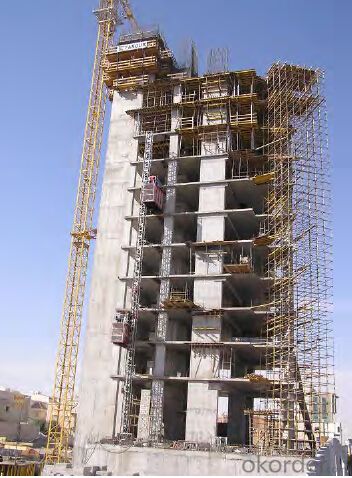
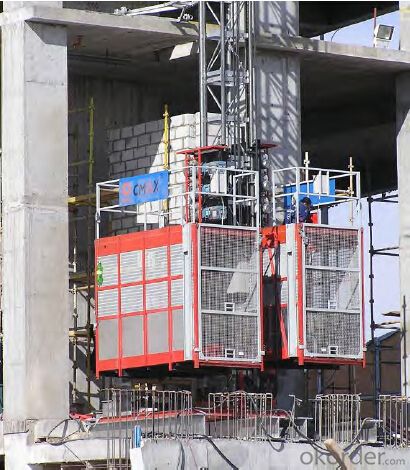
Main Parts of Construction Hoist
● The gearing adopts imported bearing, enameled cable, and oil seal.
● The electric parts adopt products from world renowned manufactures such as Schneider, Siemens, and LG.
● The racks and pinion adopts special material and heat-treatment technique, which prolong the life of these parts.
● The steel structure uses quality steel from famous domestic manufactures.
● The surface of the structure can apply paint-spray, parkerozing baking finish or hot galvanizing processing according
to users requirements,
● The cage can be produced and decorated by aluminum molded board, punched-plate or figured aluminm board.
FAQ of Construction Hoist
Q: What is the building hoist main purpose?
A: Building hoist equipped with double or single cabin to transport the materials and labors up and down. It's the ideal
construction equipment for vertical transportation in the field of construction.
Q: What is the main structure of building hoist?
A: The P/M construction hoist mainly contains metal structure, driving system, electrical control system, cable guide &
protection system, electrical top crane and safety device.
Q: What is the meaning of the building hoist’s code?
A: Take SC200/200 for example: “SC” stands for rack and pinion hoist, “200/200” stands for double cage and capacity
is 2 tons per cage. “SC200” stands for single cage and capacity is 2 tons.
Q: What is the dimension of the cage?
A: Normally the cage dimension is 3X1.5X2.5M (L/W/H) for 2t type hoist. Details should be checked according to our
quotation sheet. Also, the size can be customized according to the factual site condition. There are two doors (entrance
& exit doors) for each cage, It can be produced as up & down sliding or ramping model for safety and convenience.
- Q: The working principle of construction elevator
- SC type construction lifter is a kind of elevator on the gear, rack drive, is mainly used in high-rise building construction, cargo transportation, the elevator can be very convenient to install and remove; It can increase with the increase of the building. There is a single cage and double cage construction elevator, and the single-cage construction lift can be a double cage lift after adding a cage and other parts. If a heavy device is configured, its payload can be doubled. The SC type construction elevator has a very reliable electrical and mechanical safety system, which is a safe and efficient vertical transportation.
- Q: Is it possible to utilize a building hoist for elevating materials to a significant height for stacking purposes?
- <p>Yes, a building hoist can be used for lifting materials that need to be stacked high. These hoists are specifically designed for construction sites to lift heavy materials vertically to different levels. They are equipped with safety features to ensure materials are lifted and stacked securely and efficiently. However, the height to which materials can be stacked will depend on the hoist's lifting capacity and the specific construction site's requirements. It's crucial to follow the manufacturer's guidelines and safety regulations when operating a building hoist to prevent accidents.</p>
- Q: Is it possible to utilize a building hoist for construction purposes?
- <p>Yes, a building hoist is specifically designed for use in construction work. It is a type of lifting equipment used to transport materials and personnel vertically within a building under construction. Building hoists are essential for efficient material handling, reducing manual labor, and ensuring the safety of workers by providing a stable and controlled method of vertical transportation. They are commonly used in high-rise construction projects and are an integral part of the construction process.</p>
- Q: How many people are there for construction workers
- At the end of the 20th century, the elevator was powered by the permanent magnet synchronous towing machine. It greatly reduces the space of the machine room, and it has the advantages of low energy consumption, energy efficiency and speed, which has greatly contributed to the development of real estate. Thyssenkrupp elevator company has developed a new type of "multiple lift" that can operate vertically. Take the size of a common car The size of the escalator is quite different: but the total area is required in the national standard. Give you a general calculation The width of the well is the width of the car. Well, the depth of the well = the car depth + 600 (for the reside) The width of the well is the width of the car. Well, the depth of the well = the car's depth + 1200 (for the rear-end). The u-shaped tourist ladder is usually around 1000kg The car is usually about 1300x1800 The steel structure shaft is width between 2200 and 2400, depending on the size of the door. The depth of the structure is about 1500, and the rear wall is empty.
- Q: Do the elevator need to be installed when the main project is in construction
- The top brass usually need to install the construction elevator.
- Q: What is the safety device for construction elevator?
- A lot of 1, anti-drop safety device 2, upper and lower limit 3, extreme limit 4, buffer spring 5, line door limit switch Single line door limit switch 7, ceiling switch 8, enclosure door lock 9, single door lock The door lock is on and off There are also many electrical safety protections
- Q: Describe the process of utilizing a computer control system for operating a building hoist.
- <p>To use a computer control system for a building hoist, first ensure the system is properly installed and integrated with the hoist's mechanical and electrical components. Begin by powering on the control system and checking for any error messages that might indicate a problem. Once the system is ready, input the desired parameters such as load weight, lifting height, and speed settings. Use the control panel to initiate the hoist's movement, monitoring the progress on the system's display. Adjust the hoist's operation in real-time as needed, ensuring safety protocols are followed. Regularly check system diagnostics for maintenance alerts and address any issues promptly to maintain optimal performance.</p>
- Q: The maximum allowable deviation of the vertical is the vertical degree when the construction elevator is installed
- The development of the elevator is in a peak state, because most of the manufacturers or individuals to improve the utilization efficiency of space, more options for multistory buildings, which also need a device to convenient up and down by the goods. Due to the common elevator cost is high, bearing capacity is low, not suitable for carrying dozens of tons or hundreds of tons of cargo, so developed a high bearing capacity of hydraulic lift to assist in the production and transportation of goods. The elevators are both safe and super loadable, and convenient for maintenance, making the special industry grow faster.
- Q: Is the construction elevator the same as the construction elevator
- Construction lifter is a kind of vertical lifting equipment standard name, generally refers to the SC model of the single or double hoisting cage hoisting cage, driven by gear and rack, (in recent years, there are many strands of wire rope drive), equipped with "" for safety device, can people goods with multiplication. The construction elevator is called a popular term, and the common site is called a rack elevator and a human cargo elevator, which means the same thing. Because this kind of product applies only to the construction site, it is very different from the common guest elevator. There are two other types of products that are common to this type of product, such as the SS single-column double cage (wire rope drive), which is called the material lift machine, which cannot be multiplied by people. There is also the WJ series double column single-cage (wire rope drive), which is called the dragon door frame, which is also not allowed to be passenger. Strictly speaking, the latter two kinds can't be called construction elevator, can be called so-and-so elevator. Above is a person's humble opinion, if be in and out, still hope the expert is correct!
- Q: Is it possible to utilize a building hoist for the transportation of heavy objects?
- <p>Yes, a building hoist is specifically designed to move heavy objects within a construction site or in similar environments. It is a type of crane that can lift and lower materials vertically, making it ideal for transporting heavy items such as construction materials, machinery, and equipment. Building hoists are engineered to handle significant weight loads and are an essential tool for efficient material movement in vertical construction projects.</p>
Send your message to us
Construction Hoist SC200Z,by Aluminum Molded Board, Punched-plate or Figured Aluminm Board
- Loading Port:
- China main port
- Payment Terms:
- TT or LC
- Min Order Qty:
- 1 unit
- Supply Capability:
- 30 unit/month
OKorder Service Pledge
OKorder Financial Service
Similar products
Hot products
Hot Searches
Related keywords
